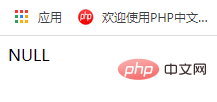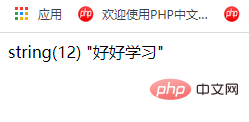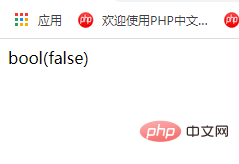Master PHP's if else syntax and NULL data type in 5 minutes
In the previous article, I brought you "An exciting and easy-to-remember summary of PHP variable knowledge (details)". This article continues to bring you an explanation and introduction of PHP knowledge. Let’s take a look at the common if else syntax and NULL data type in PHP. They are all basic knowledge. I hope it can help everyone!

if-else syntax in PHP
if and else syntax is an important syntax in PHP. It is recommended that everyone must master the if statement proficiently. It is the simplest type of process control. Only determine whether a certain condition is true, and if it is true, execute a specific statement block.
if and else syntax have four basic syntaxes:
ifstatement: when the condition is true (also is a single line of code that is executed when the condition is true). Code examples are as follows:
<?php if(布尔条件) 布尔值为真(true)时执行的代码; ?>
In actual use, we often have more than one code to execute. At this time, a simple code cannot satisfy us. When writing multiple lines of code, we only need Use braces {} to wrap the code to represent a whole; if there is only one statement to be executed, you can omit the brace mark. Then you can extend another basic syntax:
Multiple lines of code that are executed when the condition is true (that is, when the condition is true).
<?php
if(布尔条件){
布尔值为真(true)时执行,可写多行代码;
}
?>if...elsestatement, in actual use, it is not enough to have only one condition true, so There is also an if else statement, which can not only determine whether the condition is true, but also determine whether the condition is false. A single line of code that is executed when the condition is true (that is, when the condition is true), and another single line of code that is executed when the condition is not true (that is, when the condition is false). The code example is as follows:
<?php if(布尔条件) 布尔值为真(true)时执行的代码; else 布尔值为假(false)时执行的代码; ?>
Multiple lines of code executed when the condition is true (that is, when the condition is true).
<?php
if(布尔条件){
布尔值为真(true)时执行,可写多行代码;
}
?>if...else statement - multiple lines of code that are executed when the condition is true (that is, when the condition is true), and when the condition is not true (that is, the condition is false) another multiple lines of code executed.
<?php
if(布尔条件){
布尔值为真(true)时执行,可写多行代码;
}else{
布尔值为假(false)时执行,可写多行代码;
}
?>Then actually put together, the example is as follows:
The variable assignment is true, so the code when the condition is true is output in the if conditional statement, also That is: study hard and make progress every day.
<?php
//定义一个变量为真(true),也就是布尔值为true
$a = true;
//运行if条件
if($a){
//变量为真则输出:好好学习天天向上
echo '好好学习';
echo '天天向上';
}else{
//变量为假则输出:福如东海寿比南山
echo '福如东海';
echo '寿比南山';
}
?>Output result:

php data type null type
NULL is a type in PHP A special data type that has only one value, NULL, which represents a null value (the variable has no value) and does not represent spaces.
When the following conditions are met, the value of the variable is NULL:
The variable is assigned a NULL value;
<?php //声明变量为null,变量被指定为NULL $a = null; var_dump($a); ?>
Output result:

Before a variable is assigned a value, the default value is NULL;
<?php //var_dump显示输出变量$a,但$a未被赋值。 var_dump($a); ?>
Output result:

After using the unset() function to delete a variable, this variable The value is also NULL.
<?php //声明一个变量$a $a = '好好学习'; //unset销毁掉一个变量unset($a),这个变量值也为NULL var_dump($a); ?>
Output result:

Related to NULL Two functions: empty() and isset()
empty() A variable is passed in the brackets. If the value of the variable is false or null, it is passed out. is true. An example is as follows:
<?php
//给变量赋值为null,也可以试试flase。
$a = null;
//运行if和empty
if(empty($a)){
//empty传出的是true
echo '好好学习';
}else{
//empty传出的不是true
echo '天天向上';
}
?>Output result:

It can be seen that the variable a is passed as null through empty() out true.
#isset() Pass one or more variables between the brackets, and separate variables with commas. As long as there is a variable that is null, it returns false. Otherwise, returns true. For example:
One variable:
<?php //一个变量为null, $a = null; $b = isset($a); var_dump($b); ?>
The output result is:

Multiple variables :
<?php //多个变量赋值 $a = 1; $b = false; $c = 0; $d = null; //运行isset,多个变量,其中有一个null $all = isset($a , $b , $c , $d); var_dump($all); ?>
The output result is:

It can be seen that through isset(), multiple variables with nulls in them are passed to flase .
Recommended learning: "PHP Video Tutorial"
The above is the detailed content of Master PHP's if else syntax and NULL data type in 5 minutes. For more information, please follow other related articles on the PHP Chinese website!

Hot AI Tools

Undresser.AI Undress
AI-powered app for creating realistic nude photos

AI Clothes Remover
Online AI tool for removing clothes from photos.

Undress AI Tool
Undress images for free

Clothoff.io
AI clothes remover

Video Face Swap
Swap faces in any video effortlessly with our completely free AI face swap tool!

Hot Article

Hot Tools

Notepad++7.3.1
Easy-to-use and free code editor

SublimeText3 Chinese version
Chinese version, very easy to use

Zend Studio 13.0.1
Powerful PHP integrated development environment

Dreamweaver CS6
Visual web development tools

SublimeText3 Mac version
God-level code editing software (SublimeText3)

Hot Topics
 PHP 8.4 Installation and Upgrade guide for Ubuntu and Debian
Dec 24, 2024 pm 04:42 PM
PHP 8.4 Installation and Upgrade guide for Ubuntu and Debian
Dec 24, 2024 pm 04:42 PM
PHP 8.4 brings several new features, security improvements, and performance improvements with healthy amounts of feature deprecations and removals. This guide explains how to install PHP 8.4 or upgrade to PHP 8.4 on Ubuntu, Debian, or their derivati
 7 PHP Functions I Regret I Didn't Know Before
Nov 13, 2024 am 09:42 AM
7 PHP Functions I Regret I Didn't Know Before
Nov 13, 2024 am 09:42 AM
If you are an experienced PHP developer, you might have the feeling that you’ve been there and done that already.You have developed a significant number of applications, debugged millions of lines of code, and tweaked a bunch of scripts to achieve op
 How To Set Up Visual Studio Code (VS Code) for PHP Development
Dec 20, 2024 am 11:31 AM
How To Set Up Visual Studio Code (VS Code) for PHP Development
Dec 20, 2024 am 11:31 AM
Visual Studio Code, also known as VS Code, is a free source code editor — or integrated development environment (IDE) — available for all major operating systems. With a large collection of extensions for many programming languages, VS Code can be c
 Explain JSON Web Tokens (JWT) and their use case in PHP APIs.
Apr 05, 2025 am 12:04 AM
Explain JSON Web Tokens (JWT) and their use case in PHP APIs.
Apr 05, 2025 am 12:04 AM
JWT is an open standard based on JSON, used to securely transmit information between parties, mainly for identity authentication and information exchange. 1. JWT consists of three parts: Header, Payload and Signature. 2. The working principle of JWT includes three steps: generating JWT, verifying JWT and parsing Payload. 3. When using JWT for authentication in PHP, JWT can be generated and verified, and user role and permission information can be included in advanced usage. 4. Common errors include signature verification failure, token expiration, and payload oversized. Debugging skills include using debugging tools and logging. 5. Performance optimization and best practices include using appropriate signature algorithms, setting validity periods reasonably,
 PHP Program to Count Vowels in a String
Feb 07, 2025 pm 12:12 PM
PHP Program to Count Vowels in a String
Feb 07, 2025 pm 12:12 PM
A string is a sequence of characters, including letters, numbers, and symbols. This tutorial will learn how to calculate the number of vowels in a given string in PHP using different methods. The vowels in English are a, e, i, o, u, and they can be uppercase or lowercase. What is a vowel? Vowels are alphabetic characters that represent a specific pronunciation. There are five vowels in English, including uppercase and lowercase: a, e, i, o, u Example 1 Input: String = "Tutorialspoint" Output: 6 explain The vowels in the string "Tutorialspoint" are u, o, i, a, o, i. There are 6 yuan in total
 How do you parse and process HTML/XML in PHP?
Feb 07, 2025 am 11:57 AM
How do you parse and process HTML/XML in PHP?
Feb 07, 2025 am 11:57 AM
This tutorial demonstrates how to efficiently process XML documents using PHP. XML (eXtensible Markup Language) is a versatile text-based markup language designed for both human readability and machine parsing. It's commonly used for data storage an
 Explain late static binding in PHP (static::).
Apr 03, 2025 am 12:04 AM
Explain late static binding in PHP (static::).
Apr 03, 2025 am 12:04 AM
Static binding (static::) implements late static binding (LSB) in PHP, allowing calling classes to be referenced in static contexts rather than defining classes. 1) The parsing process is performed at runtime, 2) Look up the call class in the inheritance relationship, 3) It may bring performance overhead.
 What are PHP magic methods (__construct, __destruct, __call, __get, __set, etc.) and provide use cases?
Apr 03, 2025 am 12:03 AM
What are PHP magic methods (__construct, __destruct, __call, __get, __set, etc.) and provide use cases?
Apr 03, 2025 am 12:03 AM
What are the magic methods of PHP? PHP's magic methods include: 1.\_\_construct, used to initialize objects; 2.\_\_destruct, used to clean up resources; 3.\_\_call, handle non-existent method calls; 4.\_\_get, implement dynamic attribute access; 5.\_\_set, implement dynamic attribute settings. These methods are automatically called in certain situations, improving code flexibility and efficiency.






